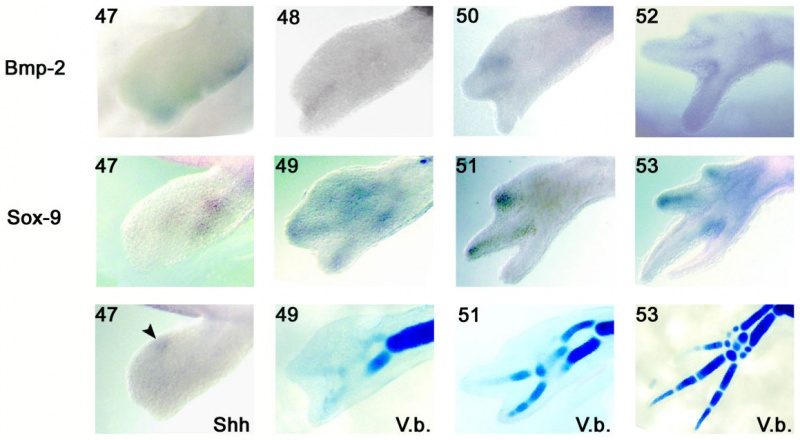File:Axolotl developing limb Bmp2 and Sox9.jpg

Original file (1,159 × 638 pixels, file size: 105 KB, MIME type: image/jpeg)
Axolotl Developing Limb Bmp2 and Sox9
Expression patterns (whole mount in situ hybridisation) for BMP-2, SOX-9 and Shh in developing limbs and cartilage staining (Victoria blue V.b.).
All pictures show a dorsal view of the limb with the posterior side on top. Numbers in the upper left of each panel refers to the developmental stages.
Whole-mount in situ hybridization was performed on developing forelimbs of axolotl from developmental stages 41 to 53. The nomenclature of Nye et al. [51] was used to determine the staging and to label the digits of the forelimb. Digit 1 is the anterior most (corresponding to the index side in human) and digit 4 the posterior most.
At stage 47, the expression of BMP-2 was mainly detected as a narrow band that surrounded the anterior border of the limb bud and extended slightly to the posterior part of the distal end. Prior to stage 47, the expression of BMP-2 was expressed as a band at the edge of the limb covering both the anterior to posterior portions of the limb (data not shown) as described previously for Xenopus laevis [52]. SOX-9 was also expressed in the anterior portion of the limb bud at stage 47 while Shh expression is restricted to the posterior (i.e. opposite to that of BMP-2; Figure 1). At stage 48, the expression of BMP-2 had become restricted to the interdigital space between the developing digits 1 and 2 and is adjacent to the expression of SOX-9 in these two digits at stage 49 (Figure 1). At this stage, SOX-9 expression correlates with the developing cartilage elements of the wrist (carpals) and the first two digits (phalanges) (Figure 1; Victoria blue of stage 49). At stage 50, BMP-2 was mainly expressed between developing digits 2 and 3 and was adjacent to the expression of SOX-9 in these two digits at stage 51 (Figure 1). At this stage, the expression of SOX-9 at the tip of digit 2 correlated with the formation of skeletal elements in digit 2 (i.e. the phalanges) and the expression in digit 3 primordium was not yet associated with skeletal elements as revealed by Victoria blue staining (Figure 1; Victoria blue of stage 51). Finally, at stage 52, BMP-2 was expressed between developing digits 3 and 4 and was adjacent to the expression of SOX-9 in these two digits at stage 53 (Figure 1). At that stage, the expression of SOX-9 at the tip of digit 3 correlated with the formation of skeletal elements in digit 3 but the expression in digit 4 primordium was not yet associated with skeletal elements as revealed by Victoria blue staining (Figure 1; Victoria blue of stage 53). In addition to its expression between digits 3 and 4 at stage 52, BMP-2 expression was still detectable at the base of all 4 digits.
Reference
<pubmed>20152028</pubmed>| BMC Dev Biol.
Guimond et al. BMC Developmental Biology 2010 10:15 doi:10.1186/1471-213X-10-15 1471-213X-10-15-1-l.jpg
© 2010 Guimond et al; licensee BioMed Central Ltd. This is an Open Access article distributed under the terms of the Creative Commons Attribution License (http://creativecommons.org/licenses/by/2.0), which permits unrestricted use, distribution, and reproduction in any medium, provided the original work is properly cited.
File history
Click on a date/time to view the file as it appeared at that time.
| Date/Time | Thumbnail | Dimensions | User | Comment | |
|---|---|---|---|---|---|
| current | 19:17, 3 November 2011 |  | 1,159 × 638 (105 KB) | S8600021 (talk | contribs) | ==Axolotl Developing Limb Bmp2 and Sox9== Expression patterns (whole mount in situ hybridisation) for BMP-2, SOX-9 and Shh in developing limbs and cartilage staining (Victoria blue V.b.). All pictures show a dorsal view of the limb with the posterior si |
You cannot overwrite this file.
File usage
The following page uses this file: